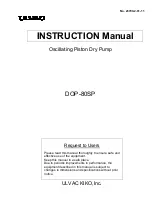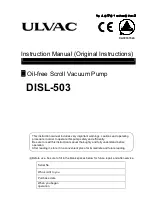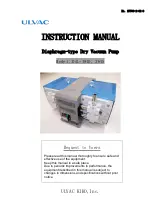
OM−05267
SUPER T SERIES
PAGE B − 5
INSTALLATION
from excessive shock pressure and reverse rota-
tion when it is stopped.
If the application involves a high discharge
head, gradually close the discharge
throttling valve before stopping the pump.
Bypass Lines
Self-priming pumps are not air compressors. Dur-
ing the priming cycle, air from the suction line must
be vented to atmosphere on the discharge side. If
the discharge line is open, this air will be vented
through the discharge. However, if a check valve
has been installed in the discharge line, the dis-
charge side of the pump must be opened to atmos-
pheric pressure through a bypass line installed be-
tween the pump discharge and the check valve. A
self-priming centrifugal pump
will not prime
if
there is sufficient static liquid head to hold the dis-
charge check valve closed.
NOTE
The bypass line should be sized so that it does not
affect pump discharge capacity; however, the by-
pass line should be at least 1 inch in diameter to
minimize the chance of plugging.
In
low discharge head
applications
(less than 30
feet or 9 meters), it is recommended that the by-
pass line be run back to the wet well, and located 6
inches below the water level or cut-off point of the
low level pump. In some installations, this bypass
line may be terminated with a six-to-eight foot
length of 1 1/4 inch I.D.
smooth-bore
hose; air and
liquid vented during the priming process will then
agitate the hose and break up any solids, grease,
or other substances likely to cause clogging.
A bypass line that is returned to a wet well
must be secured against being drawn into
the pump suction inlet.
It is also recommended that pipe unions be in-
stalled at each 90
_
elbow in a bypass line to ease
disassembly and maintenance.
In
high discharge head applications
(more than
30 feet), an excessive amount of liquid may be by-
passed and forced back to the wet well under the
full working pressure of the pump; this will reduce
overall pumping efficiency.
Therefore, it is recom-
mended that a Gorman-Rupp Automatic Air Re-
lease Valve be installed in the bypass line.
Gorman-Rupp Automatic Air Release Valves are
reliable, and require minimum maintenance. See
AUTOMATIC AIR RELEASE VALVE
in this section
for installation and theory of operation of the Auto-
matic Air Release Valve. Consult your Gorman-
Rupp distributor, or contact the Gorman-Rupp
Company for selection of an Automatic Air Release
Valve to fit your application.
If the installation involves a flooded suction such as
a below-ground lift station. A pipe union and manu-
al shut-off valve may be installed in the bleed line to
allow service of the valve without shutting down the
station, and to eliminate the possibility of flooding.
If a manual shut-off valve is installed
anywhere
in
the air release piping, it
must
be a full-opening
ball
type
valve to prevent plugging by solids.
If a manual shut-off valve is installed in
a bypass line, it must not be left closed
during operation. A closed manual shut-
off valve may cause a pump which has
lost prime to continue to operate with-
out reaching prime, causing dangerous
overheating and possible explosive
rupture of the pump casing. Personnel
could be severely injured
.
Allow an over-heated pump to com-
pletely cool before servicing
.
Do not
re-
move plates, covers, gauges, or fittings
from an over-heated pump. Liquid with-
in the pump can reach boiling tempera-
tures, and vapor pressure within the
pump can cause parts being disen-
gaged to be ejected with great force. Af-












































